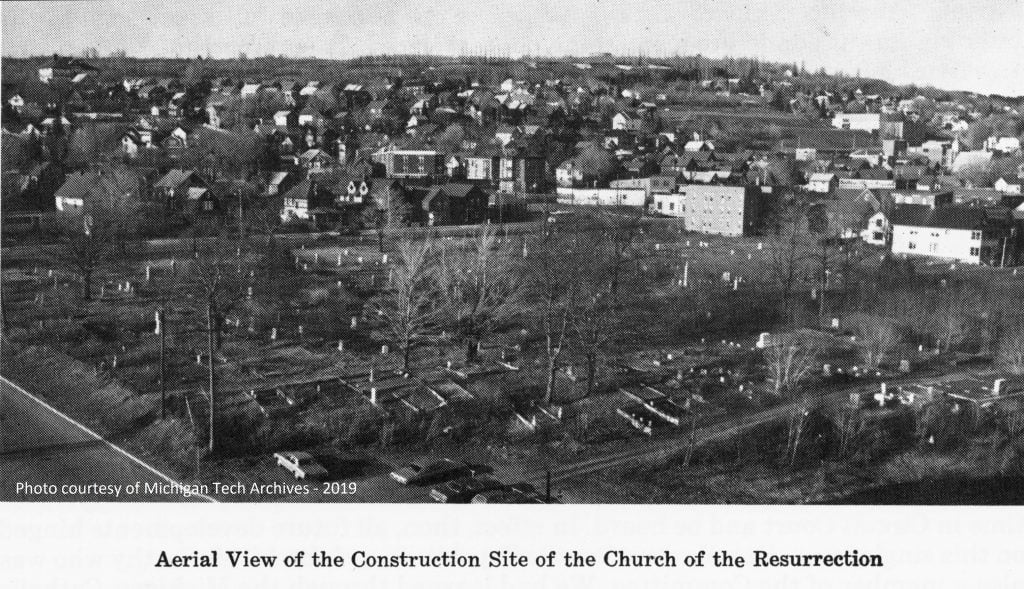
Many Copper Country visitors whose ancestors once called the Keweenaw Peninsula home hope to see where these family members have been laid to rest. Standing by the grave of someone who died decades or more than a century ago provides an opportunity to reflect on his life–or on one’s own–and to pay respects.
It’s an easy enough activity for many: cemeteries in Calumet, Lake Linden, Houghton, Hancock, and throughout the rest of the Copper Country offer grassy lanes for strolling and looking for headstones. Records held at the Michigan Tech Archives, with government offices, and at the cemeteries themselves can help to narrow down exactly where in the burial ground one should search for relatives. Yet the Copper Country also has a number of cemeteries lost to the sands of time and to changes in how communities decided to use their land. This week’s Flashback Friday profiles just two of the cemeteries that are no longer with us.
Early in the history of Hancock, two strains of Christian congregations–Catholic and Protestant–established distinct cemeteries at the western edge of town. Faithful from St. Patrick’s or St. Joseph’s Catholic churches would be buried in their own hallowed ground; members of the town’s numerous Lutheran churches, its Congregational organizations, and other Protestant denominations found their places of rest in an adjacent park slightly further west. Sales of lots at the Protestant cemetery, according to research compiled by John M. Blom, have been documented as far back as 1866; the Catholic (St. Joseph) cemetery was almost certainly established at about the same time.
For decades, families and friends made the sad journey from funeral parlors, private homes, and places of worship to lay their loved ones to rest in the two distinct cemeteries. In 1896, however, a new municipal cemetery was incorporated. Lakeside Cemetery sat perched on a bluff, promising cool breezes off the Portage Canal and, as a carpet of trees grew around it, shade and quiet away from the bustle of the city. Here, Catholics and Protestants would be buried side-by-side, although the Sisters of St. Joseph of Carondelet reserved a section for their faithful members. As residents of Hancock increasingly embraced Lakeside for a burial ground, the deterioration of the Catholic and Protestant cemeteries accelerated. By the middle of the 20th century, many years had passed since anyone had been laid to rest in either of the old sectarian burial grounds.
At the same time, the congregations that had once supported these cemeteries found themselves at a crossroads. Like many mining towns, Hancock’s Catholic and Evangelical Lutheran churches had been founded on ethnic lines, with German families or Finns joining others of their background for Sunday worship in their native tongues. In the 1960s, clergymen had largely abandoned preaching in Finnish or German; English was the lingua franca now. Houghton County’s population had also fallen into decline as one mine after another closed. Consolidation in a new Lutheran building and a new Catholic parish made sense. Amidst great controversy, the congregations selected the old burial grounds for the new construction. Gloria Dei Lutheran Church would be erected on the space occupied by the Protestant cemetery; the aptly-named Church of the Resurrection would take the place of the Catholic burial ground.

Surviving relatives of those who had been buried in the cemeteries were apparently given the opportunity to claim their family members and have them reinterred at Lakeside. For many of the deceased, however, there were no claimants: few had surviving family members, let alone ones who remembered that a great-grandfather or a distant great-aunt had been buried in a now-overgrown cemetery in the 1870s. Headstones that remained were removed–some to Lakeside, with the individuals they described, and some to a memorial that the Church of the Resurrection hoped to create on its grounds. Repeated vandalism stymied that effort and, by the late 1980s, the church conceded defeat. Today, at both Gloria Dei and Resurrection, plaques mark the location of the old cemeteries. Adjacent to the Lutheran church sits a small park where visitors can honor the dead who still rest there, their presence persistent if invisible.
That picture brought back memories of my walks to work at St. Joe’s Hospital. I would take the path through the cemetery in the early morning hours enjoying the quiet setting.
Thank you for the beautifully written tribute to those who rest in peace there lest we forget.